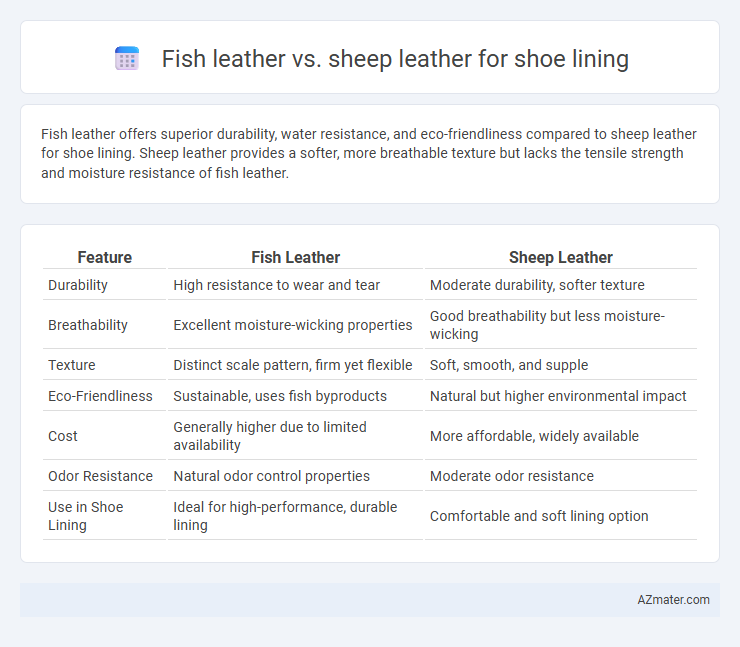Fish leather offers superior durability, water resistance, and eco-friendliness compared to sheep leather for shoe lining. Sheep leather provides a softer, more breathable texture but lacks the tensile strength and moisture resistance of fish leather.
Table of Comparison
| Feature | Fish Leather | Sheep Leather |
|---|---|---|
| Durability | High resistance to wear and tear | Moderate durability, softer texture |
| Breathability | Excellent moisture-wicking properties | Good breathability but less moisture-wicking |
| Texture | Distinct scale pattern, firm yet flexible | Soft, smooth, and supple |
| Eco-Friendliness | Sustainable, uses fish byproducts | Natural but higher environmental impact |
| Cost | Generally higher due to limited availability | More affordable, widely available |
| Odor Resistance | Natural odor control properties | Moderate odor resistance |
| Use in Shoe Lining | Ideal for high-performance, durable lining | Comfortable and soft lining option |
Introduction to Fish Leather and Sheep Leather
Fish leather, derived primarily from species such as salmon and cod, offers exceptional durability and a unique textured appearance ideal for shoe lining, while sheep leather is renowned for its softness and breathability, providing superior comfort and flexibility. The collagen fibers in fish leather are tightly packed, contributing to its toughness and resistance to wear, whereas sheep leather's fine grain enhances moisture absorption and flexibility. Both materials present distinct benefits in shoe lining, with fish leather excelling in strength and sheep leather favoring comfort and breathability.
Origins and Production Processes
Fish leather, sourced primarily from salmon, cod, and perch, originates from fisheries as a sustainable byproduct often discarded during fish processing. Its production involves tanning methods that retain natural moisture and flexibility, resulting in a durable yet breathable material ideal for shoe lining. Sheep leather, derived from sheep hides in traditional livestock farming, undergoes conventional tanning processes emphasizing softness and stretchability, making it a widely used option for comfortable shoe interiors.
Unique Properties of Fish Leather
Fish leather for shoe lining offers unparalleled durability and breathability due to its unique scale structure, which enhances moisture regulation and reduces odor buildup. Its natural texture provides a lightweight yet strong alternative to traditional sheep leather, promoting flexibility and comfort in footwear. The sustainability aspect of fish leather, derived from byproducts of the fishing industry, further distinguishes it as an innovative, eco-friendly choice for premium shoe linings.
Distinct Qualities of Sheep Leather
Sheep leather for shoe lining offers exceptional softness and breathability, making it comfortable for prolonged wear and reducing foot perspiration. Its natural flexibility and fine grain structure contribute to better moisture absorption compared to fish leather, enhancing overall foot hygiene. Additionally, sheep leather's durability and resistance to cracking ensure long-lasting performance while maintaining a smooth, supple interior in footwear.
Durability Comparison: Fish vs Sheep Leather
Fish leather exhibits superior durability compared to sheep leather for shoe lining, offering increased resistance to abrasion and wear due to its dense collagen fiber structure. The natural strength of fish leather contributes to enhanced longevity and maintains shape better under prolonged use, whereas sheep leather tends to soften and degrade faster in high-friction environments. This makes fish leather an optimal choice for shoe linings requiring toughness and endurance in demanding conditions.
Comfort and Breathability in Shoe Linings
Fish leather offers superior breathability and moisture-wicking properties compared to sheep leather, enhancing comfort in shoe linings by reducing sweat accumulation and odor. Its natural porous structure allows better air circulation, maintaining foot dryness during extended wear. Sheep leather, while soft and durable, tends to retain more moisture, potentially compromising breathability and comfort over long periods.
Sustainability and Environmental Impact
Fish leather for shoe lining offers a sustainable alternative to traditional sheep leather by utilizing byproducts from the fishing industry, reducing waste and resource consumption. It requires fewer chemicals and less water during processing compared to sheep leather, resulting in a lower environmental footprint. Sheep leather production often involves intensive grazing and high methane emissions, making fish leather a more eco-friendly option for environmentally conscious footwear.
Style and Aesthetic Differences
Fish leather for shoe lining offers a unique, scaled texture that enhances the shoe's visual appeal with a natural, exotic pattern often unavailable in sheep leather. Sheep leather provides a smooth, supple finish that ensures a classic and refined look, favored in traditional shoe designs. The distinctive sheen and pattern variation in fish leather create bold style statements, while sheep leather maintains timeless elegance and understated aesthetics.
Care, Maintenance, and Longevity
Fish leather, known for its unique scale patterns and natural durability, requires gentle cleaning with a damp cloth and occasional moisturizing to maintain suppleness, ensuring longevity in shoe lining applications. Sheep leather, valued for its soft texture and breathability, demands regular conditioning with specialized leather creams to prevent drying and cracking, thus extending the lifespan of shoe interiors. Both materials benefit from avoiding excessive moisture and direct sunlight, but fish leather generally offers enhanced resistance to wear and tear, making it a durable, eco-friendly option for premium shoe linings.
Choosing the Right Leather for Shoe Linings
Fish leather offers superior breathability and moisture-wicking properties compared to sheep leather, making it ideal for shoe linings in humid conditions. Sheep leather, known for its softness and durability, provides excellent comfort and flexibility, which benefits everyday footwear. Choosing between fish and sheep leather depends on the desired balance of ventilation, durability, and comfort for specific shoe lining needs.

Infographic: Fish leather vs Sheep leather for Shoe lining
 azmater.com
azmater.com